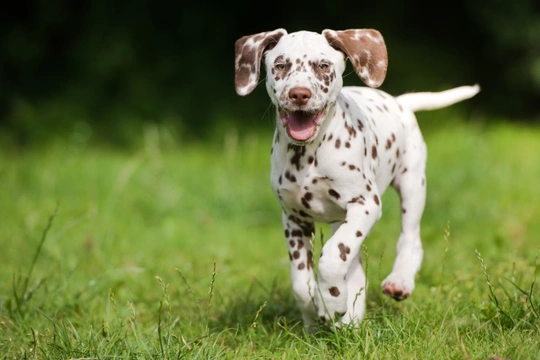
Dalmatian Spots: 5 Fascinating Facts You Didn't Know
The Dalmatian is the ubiquitous spotty dog breed, made famous by the film 101 Dalmatians and subsequent spin-offs, and the breed as a whole is best known for their distinctive white and black or white and liver spotted coats.
As well as giving Dalmatians a very handsome and eye-catching appearance, the Dalmatian’s spots are very interesting in and of themselves, in terms of how they develop, how they are presented, and their heredity.
In fact, the Dalmatian dog is the world’s only truly spotted dog breed – although this is not always obvious! Great Danes, for instance, can be found with a similar specific coat colour and pattern combination that is known as harlequin, which is unique within the Great Dane breed, and which can be traced back to a specific DNA locus modifier relating to the trait’s heredity.
If you own a Dalmatian or are considering buying one, or if a dog of the breed has simply caught your eye and you want to find out more about the Dalmatian coat and how its spots form, this article is for you.
Read on to learn five interesting facts about the Dalmatian dog’s spots and coat.
Dalmatian puppies aren’t born with spots
First up, it comes as a surprise to many dog lovers to learn that Dalmatians aren’t born with their spots! Dalmatian puppies are born with a pure white base coat, and their spots only begin to develop and become apparent later on, which makes predicting the colour and pattern distribution on the coat of any puppy something of a guessing game.
Generally, Dalmatian puppies start to exhibit the first flecks of coloured hairs in their coats from around the age of two weeks old onwards, and as the pups approach three or four weeks old, the first real and clearly defined colour spots begin to become apparent.
However, it can take many months for a Dalmatian’s full, final adult coat colour and pattern distribution to become clear, and the definition of the spots themselves and even the number of them is apt to continue to develop over time until they are fully grown. That said, most pups will largely display their adult coat appearance by the time they are a couple of months old.
The spots are displayed on the skin as well as the coat
The Dalmatian’s spots aren’t just reflected in the colour pigment of their coat, but also present on the skin too. You may be able to spot this on the dog’s belly where the fur is sparser and the skin more visible, and if your dog ever needs to have an area of fur shaved for surgery (such as spaying) you will see their spotty pattern reflected on the underlying skin.
Dalmatians can even have spots of colour inside of their mouths too!
Dalmatian spots come in quite a range of colours, but some are very rare
The two standard Dalmatian colours that most of us are familiar with and that are reflected in the Dalmatian breed standard are black spots on a white background, and brown or rather, liver spots on a white background respectively.
However, these are not the only possible colours for a Dalmatian’s spots, and there are several other varieties too, including lemon, blue, brindle and mosaic. Some Dalmatians are referred to as tricolour too, reflecting both black spots and liver spots present within the same coat.
The desirable appearance of Dalmatian spots
Within the Dalmatian breed standard in the UK as devised by the Kennel Club, a Dalmatian coat is described as being pure white with dense, clearly defined spots in either black or liver. The spots should not run or blend together to form patches, although some patching on the head and ears is considered to be acceptable.
Dalmatians displaying tricolour spots or spots in a colour other than liver or black are unacceptable within the breed standard.
The perfect pattern distribution for Dalmatian spotting is crisp, clearly defined spots of around 2-3cm each, evenly distributed across the coat as a whole, with spots on the dog’s extremities (like the legs and tail) being smaller than those on the trunk and body.
The piebald gene and hereditary deafness
The Dalmatian’s coat colour and pattern combination is a hereditary breed factor, dictated by the combination of genes that the dog inherits. The specific gene that causes spots in the Dalmatian breed is a type of piebald gene, which simply presents in the Dalmatian in a very unique manner by causing spots and not patches of colour.
However, the piebald gene found within the Dalmatian breed can do more than simply achieve the breed’s recognisable coat style, and can also come accompanied with increased risk factors for hereditary deafness in the dogs that inherit it.
Often, it is Dalmatians that only have quite sparse spotting and a largely white coat that have higher than usual odds of being deaf. A significant proportion of Dalmatians are either partially deaf/deaf in one ear or completely deaf in both ears, and this is widely recognised within the breed as a whole.
If you are considering buying a Dalmatian puppy, it is important to learn more about how their spots can increase the chances of their being born deaf, and take steps to assess the hearing of any pup you are considering buying before you commit to a purchase.



